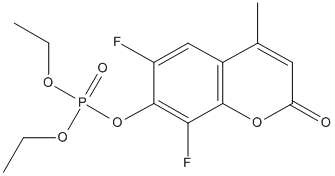DEPFMU
General
Type : Fluorescent Probe || Organophosphate || Flu-OP || Coumarin
Chemical_Nomenclature : (6,8-difluoro-4-methyl-2-oxochromen-7-yl) diethyl phosphate
Canonical SMILES : CCOP(=O)(OCC)OC1=C(C=C2C(=CC(=O)OC2=C1F)C)F
InChI : InChI=1S\/C14H15F2O6P\/c1-4-19-23(18,20-5-2)22-14-10(15)7-9-8(3)6-11(17)21-13(9)12(14)16\/h6-7H,4-5H2,1-3H3
InChIKey : CLWKOLLQGCBUMM-UHFFFAOYSA-N
Other name(s) : 7-diethylphospho-6,8-difluor-4-methylumbelliferyl, SCHEMBL3489922, 4-Methyl-6,8-difluoro-7-(diethoxyphosphinyloxy)-2H-1-benzopyran-2-one
MW : 348.23
Formula : C14H15F2O6P
CAS_number :
PubChem :
UniChem :
Iuphar :

Target
Families : No family
References (2)
| Title : A homogeneous cell-based assay for measurement of endogenous paraoxonase 1 activity - Ahmad_2010_Anal.Biochem_400_1 |
| Author(s) : Ahmad S , Carter JJ , Scott JE |
| Ref : Analytical Biochemistry , 400 :1 , 2010 |
| Abstract : Ahmad_2010_Anal.Biochem_400_1 |
| ESTHER : Ahmad_2010_Anal.Biochem_400_1 |
| PubMedSearch : Ahmad_2010_Anal.Biochem_400_1 |
| PubMedID: 20096260 |
| Title : A fluorogenic substrate for detection of organophosphatase activity - Soukharev_2004_Anal.Biochem_327_140 |
| Author(s) : Soukharev S , Hammond DJ |
| Ref : Analytical Biochemistry , 327 :140 , 2004 |
| Abstract : Soukharev_2004_Anal.Biochem_327_140 |
| ESTHER : Soukharev_2004_Anal.Biochem_327_140 |
| PubMedSearch : Soukharev_2004_Anal.Biochem_327_140 |
| PubMedID: 15033522 |